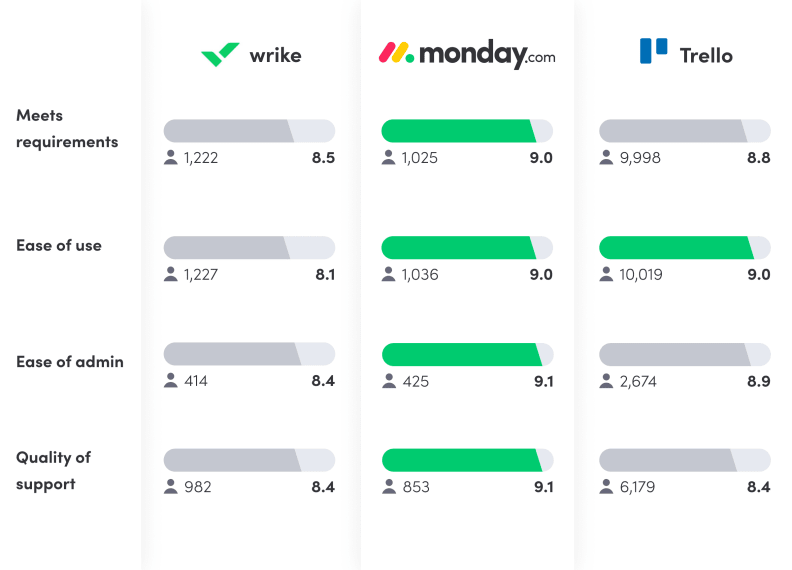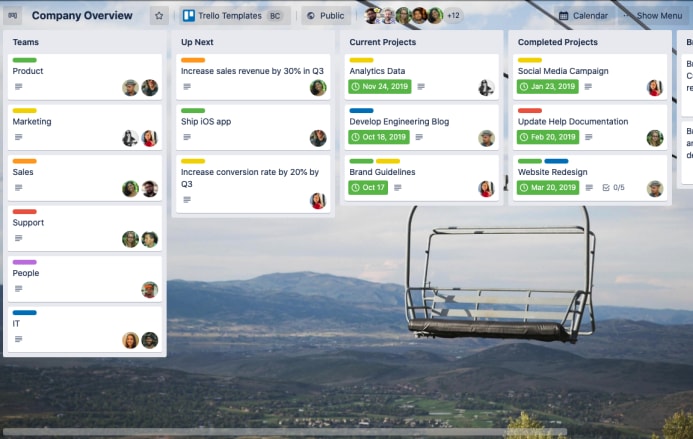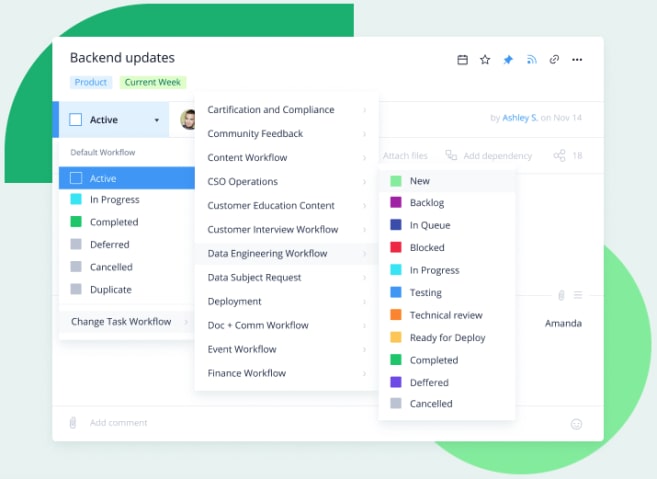With a plethora of project management tools out there, it can be really hard to figure out which exactly is the best pick for your specific needs, right?
We know a little thing or two about project management, so we thought we’d share some of our knowledge on Wrike and Trello, two project management tools, and help you find the tool of your dreams!
Let’s break it down.
What is Trello?
Trello is a Kanban-style project management tool owned by software giant Atlassian.
Fun fact: the name Trello derives from the word trellis, a structure typically used to support trees and plants!
Wondering what exactly is this Kanban we speak of?
Kanban project management is a methodology in which actionable pieces are drafted so every aspect of a project’s workflow is easy to visualize, and so team members are assigned to individual tasks that are easy to keep track of. Want to know how to visually organize projects using Kanban software? We’ve got you covered!
What is Wrike?
Wrike is also a project management tool, albeit a more expensive one than many other project management tools on the market. While it does offer more customization options than Trello (we’ll get to it soon!), it doesn’t include very many ready-to-go templates, if that’s something that’s important for you.
Want to see how Wrike compares with monday.com? Check out our monday vs Wrike comparison.
Wrike vs. Trello: what are the differences?
Since no team or manager has identical needs, you should ask yourself a few questions to help you choose the right project management tool:
- How big is my team?
- How many team members is the task management tool intended for?
- How type of customer support will I need?
- Is there a specific project management methodology I want to follow?
- What kinds of tasks will I be using this management tool for?
- What kinds of integrations do I plan on using?
- How important are time-tracking tools and reporting capabilities?
Depending on how you answered the above questions, our analysis below should help you figure out which of Trello or Wrike (or others, like monday.com) is the best fit for your task management needs.
Essentially, the biggest difference between Wrike and Trello is their options of different views!
Both of them offer Kanban boards.
But Trello is specifically tailored for creating Kanban boards and offers key metrics associated with the Kanban method like flow efficiency, while not delving deeply into other project management methodologies at all.
If Kanban just doesn’t do it for you, and you want more variety of methodologies, then perhaps you should consider options other than Trello.
If you’re looking for more view options, overarching customer support, and budget is a non-issue, then Wrike is probably a better fit for you than Trello.
If you’ve tried Wrike or Trello or even both, we’d love to hear what you think! Please share your experiences below.
Trello features and advantages over Wrike: better for tasks, and Kanban!
If you’re part of a small team and aim to become a Kanban aficionado without needing comprehensive reporting capabilities, shareable forms, or customer support on the weekend, then Trello will probably tick off enough boxes for you. We also offer a Kanban view plus tons of others, wink wink nudge nudge.
Since Trello is also owned by Atlassian, which offers another project management tool aimed at software developers called Jira, Trello offers similar features aimed at software developers.
monday.com does too, plus includes Kanban view, lots of software development-specific features, and a simple and visual interface, just saying…
Wrike features and advantages over Trello: creating forms and additional views
If Kanban isn’t the only thing you’re looking for and you want several view options, then Wrike is a better pick for you than Trello will be, probably.
Although it is more expensive than Trello, Wrike does include the ability to create and share forms with clients and team members.
In terms of templates, Wrike only caters to three fields: project management, marketing teams, and software development. So Wrike’s template may not be perfectly suited for people looking for more options.
Pricing: Trello is cheaper, but offers limited support
Trello pricing
- Free—Trello’s most basic plan is offered for free for an indefinite period, but the company’s website doesn’t state for how many people per team. However, the free plan limits users to 10 boards per team and 10 MB per file attachment.
- Business class—upgrading to Trello’s business class plan opens up unlimited boards for teams, and also email customer support with a guaranteed response within one business day. However, there is still a file attachment limit of 250 MB per file, and sets users back $9.99 per user per month.
- Enterprise—Trello’s enterprise plan offers essentially the same features as its business class plan, but for bigger teams. The price per user becomes lower as the amount of users increases, so there isn’t a set price per user.
Wrike pricing:
- Free – Wrike’s most basic plan is also free, albeit only for teams of up to five people, and also has a limit of 2 GB of storage space. Wrike’s free plan also limits users to basic integrations and limited views.
- Professional – Wrike’s professional plan costs $9.80 per user per month, and is only available for teams of up to 15 people. The professional plan also includes Gantt views, the ability to share boards with guests, and 5 GB of storage space.
- Business – their business plan comes with a price tag of $24.80 per user per month for teams of up to 200 people, granting users the ability to use automations, use templates, and customize workflow stages.
- Enterprise – like Jira, Wrike also does not list a price for their Enterprise plans, but does offer user audit reports and 100 GB of storage space.
Still looking for a Trello and Wrike alternative and want budget-friendly plans, plentiful views, AND 24/7 support? This blog post will help you choose the right monday.com plan for you, and which of our plans is best for your team!
Trello support: check your email
Trello’s free plan lists nothing about support, so it’s hard to say what kind of support, if any, its non-paying customers can expect.
For users opting for Trello’s business and enterprise plans, clients are guaranteed an email response within one business day.
Wrike customer support: no response-time guarantee
Wrike provides support through the Help Center, email, chat, and phone. That being said, the company doesn’t list a response-time guarantee. Instead of waiting on the line for hours on end, you can opt for an option to have someone return your call. That being said, there is no telling when exactly your call will be returned.
Wrike does not indicate a different level of customer service or support between plans, but does offer its consulting, training, and support services at an additional, unidentified cost.
Trello customer reviews: 4.3 / 5 on G2
On one of our personal favorite review sites G2, Trello is rated as 4.3 / 5 from more than 11,000 users.
Wrike reviews: 4.2 / 5 on G2
Also On G2, Wrike garnered a slightly lower customer satisfaction score than Trello did, coming in at 4.2 / 5 from 1,316 reviews, to be exact.
4.3 and 4.2 respectively are both objectively pretty good scores! Right?
But you deserve better! May we suggest a project management tool that garnered a whopping rating of 4.6 /5 on G2?
Sounds too good to be true? Don’t just take our not-biased-at-all word for it: in fact, more than 7,000 people ranked monday.com 4.6/5 or above on review sites, including G2, Capterra, Trustpilot, TrustRadius, and GetApp!

monday.com — your Wrike and Trello alternative
Finding a tailor-made project management tool for your very specific needs is no easy feat, so congratulations on making it this far!!
Why you should try monday.com (for free!)
No, dreaming of pretty workflows, customer support whenever, wherever, and 40+ integrations isn’t too much to ask for!! You deserve it!
This is where we come in: with monday.com, you have access to a copious amount of features (and fun widgets, like our celebratory llama in case you forgot 🦙) that will help you complete any task or project from start to finish, not to mention our incredible customer success team who have an average response time of less than 60 minutes, on literally every day of the year!
Here’s a look at just some of what our visual platform can offer you and your team:
- Hundreds of ready-made templates to get started instantly
- 8 different visual workflows, including Kanban, Gantt, map, and others
- 40+ high-quality integrations so you can bring data from the tools you already use
- The ability to create and share forms with your team members and clients
- Endless automation possibilities to automate mundane tasks and emails
Check it out yourself: try our platform now, the first two weeks are on us!
Related articles: Trello vs. Asana, Trello vs. monday.com, Trello vs. Notion, Trello vs. Airtable, Trello vs. Jira, Smartsheet vs. Trello, Trello pricing, Wrike pricing


